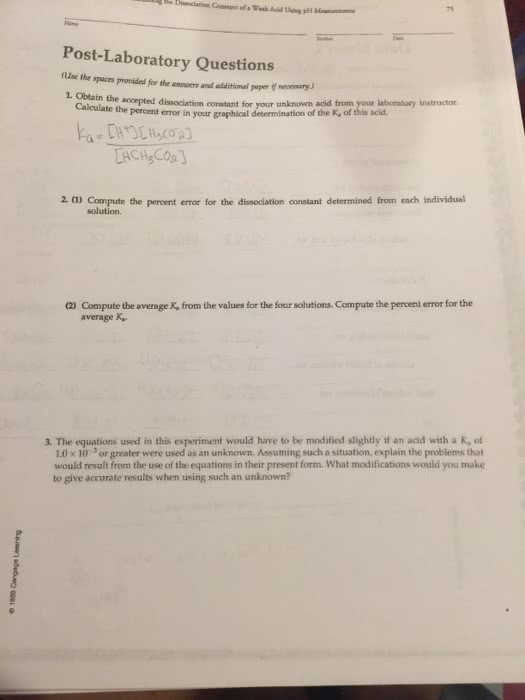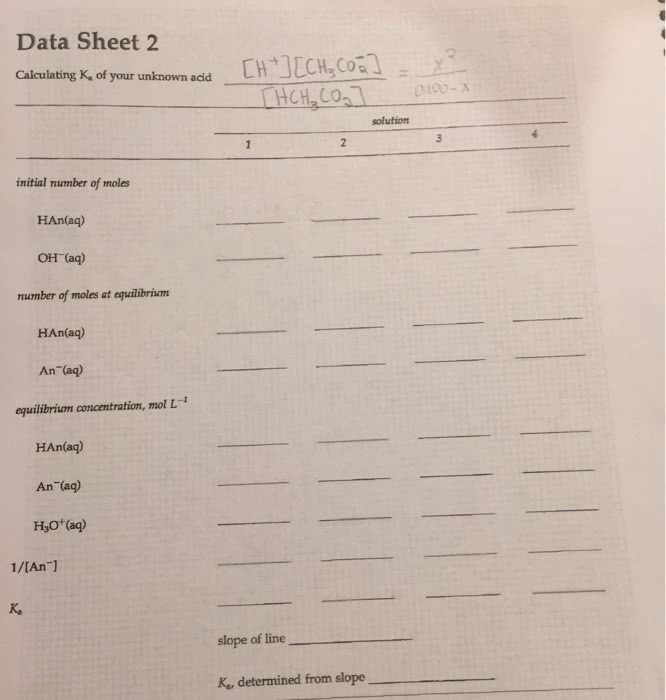1. The accepted dissociation constant for acetic acid is 1.8 x 10-5. One student's graphical determination of the Ka of this acid is 1.4 x 10-5. Calculate the percent error in this student's determination.
2.The equations used in this experiment would have to be modified slightly if an acid with a Ka of 1.0 x 10-3 or greater were used as an unknown. Assuming such a situation, explain the problems that would result from the use of the equations in their present form. What modifications would you make to give accurate results when using such an unknown?
a. The following two reactions happen in the solution. OH- + HAn LaTeX: \longrightarrow An- + H2O (Reaction 1) HAn LaTeX: \longrightarrow An- + H+ (Reaction 2) Within this lab, the acid used is a very weak acid with a Ka much smaller than 1 x 10-3. So the dissociation of the acid (Reaction 2) is negligible. The moles of An- at equilibrium is calculated as equal to the initial moles of OH-, and mole of HAn at equilibrium is calculated as the initial moles of HAn minus the initial moles of OH-.
b. When the Ka of the weak acid is equal or bigger than 1 x 10-3, the dissociation of acid (Reaction 2) is no longer negligible. In such case, An- is produced from both Reaction 1 and Reaction 2. The moles of An- produced from Reaction 1 is equal to the initial moles of OH-; and the moles of An- produced from Reaction 2 is equal to the moles of H+ (or H3O+), which can be calculated as molarity of H+ times liters of the solution mixture. So the moles of An- at equilibrium should be calculated as: moles of An- at equilibrium = initial moles of OH- + moles of H+ ; (Equation 1) And the moles of HA at equilibrium should be calculated as: moles of HA at equilibrium= initial moles of HA -moles of An- at equilibrium (Equation 2)
c. If we keep ignoring Reaction 2 even though the Ka of the weak acid is equal or bigger than 1 x 10-3, we will end up with an incorrectly smaller mole and smaller equilibrium concentration of An- and incorrectly bigger mole and bigger equilibrium concentration of HAn , thus an incorrectly smaller Ka. The problem can be avoided and an accurate determination of Ka can be obtained by calculating moles of An- at equilibrium and that of HAn by Equation 1 and Equation 2, respectively.
d. The following two reactions happen in the solution. OH- + HAn LaTeX: \longrightarrow An- + H2O (Equation 1) HAn LaTeX: \longrightarrow An- + H+ (Equation 2) Within this lab, the acid used is a very weak acid with a Ka much smaller than 1 x 10-3. So the dissociation of the acid (Equation 2) is negligible. The moles of An- at equilibrium is calculated as equal to the initial moles of OH-, and mole of HAn at equilibrium is calculated as the initial moles of HAn minus the initial moles of OH-. When the Ka of the weak acid is equal or bigger than 1 x 10-3, the dissociation of acid (Equation 2) is no longer negligible. In such case, An- is produced from both Equation 1 and Equation 2. The moles of An- produced from Equation 1 is equal to the initial moles of OH-; and the moles of An- produced from Equation 2 is equal to the moles of H+ (or H3O+), which can be calculated as molarity of H+ times liters of the solution mixture. So the moles of An- at equilibrium should be calculated as: moles of An- at equilibrium = initial moles of OH- + moles of H+ ; (Equation 3) And the moles of HA at equilibrium should be calculated as: moles of HA at equilibrium= initial moles of HA -moles of An- at equilibrium (Equation 4) If we keep ignoring Equation 2, we will end up with an incorrectly smaller equilibrium concentration of An- and incorrectly big equilibrium concentration of HAn , thus an incorrectly smaller Ka. The problem can be avoided and an accurate determination of Ka can be obtained by calculating moles of An- at equilibrium and that of HAn by Equation 3 and Equation 4 respectively.
e. all are correct
1. The accepted dissociation constant for acetic acid is 1.8 x 10-5. One student's graphical determination of the Ka of this acid is 1.4 x 10-5. Calculate the percent error in this student's determination.
2.The equations used in this experiment would have to be modified slightly if an acid with a Ka of 1.0 x 10-3 or greater were used as an unknown. Assuming such a situation, explain the problems that would result from the use of the equations in their present form. What modifications would you make to give accurate results when using such an unknown?
a. The following two reactions happen in the solution. OH- + HAn LaTeX: \longrightarrow An- + H2O (Reaction 1) HAn LaTeX: \longrightarrow An- + H+ (Reaction 2) Within this lab, the acid used is a very weak acid with a Ka much smaller than 1 x 10-3. So the dissociation of the acid (Reaction 2) is negligible. The moles of An- at equilibrium is calculated as equal to the initial moles of OH-, and mole of HAn at equilibrium is calculated as the initial moles of HAn minus the initial moles of OH-.
b. When the Ka of the weak acid is equal or bigger than 1 x 10-3, the dissociation of acid (Reaction 2) is no longer negligible. In such case, An- is produced from both Reaction 1 and Reaction 2. The moles of An- produced from Reaction 1 is equal to the initial moles of OH-; and the moles of An- produced from Reaction 2 is equal to the moles of H+ (or H3O+), which can be calculated as molarity of H+ times liters of the solution mixture. So the moles of An- at equilibrium should be calculated as: moles of An- at equilibrium = initial moles of OH- + moles of H+ ; (Equation 1) And the moles of HA at equilibrium should be calculated as: moles of HA at equilibrium= initial moles of HA -moles of An- at equilibrium (Equation 2)
c. If we keep ignoring Reaction 2 even though the Ka of the weak acid is equal or bigger than 1 x 10-3, we will end up with an incorrectly smaller mole and smaller equilibrium concentration of An- and incorrectly bigger mole and bigger equilibrium concentration of HAn , thus an incorrectly smaller Ka. The problem can be avoided and an accurate determination of Ka can be obtained by calculating moles of An- at equilibrium and that of HAn by Equation 1 and Equation 2, respectively.
d. The following two reactions happen in the solution. OH- + HAn LaTeX: \longrightarrow An- + H2O (Equation 1) HAn LaTeX: \longrightarrow An- + H+ (Equation 2) Within this lab, the acid used is a very weak acid with a Ka much smaller than 1 x 10-3. So the dissociation of the acid (Equation 2) is negligible. The moles of An- at equilibrium is calculated as equal to the initial moles of OH-, and mole of HAn at equilibrium is calculated as the initial moles of HAn minus the initial moles of OH-. When the Ka of the weak acid is equal or bigger than 1 x 10-3, the dissociation of acid (Equation 2) is no longer negligible. In such case, An- is produced from both Equation 1 and Equation 2. The moles of An- produced from Equation 1 is equal to the initial moles of OH-; and the moles of An- produced from Equation 2 is equal to the moles of H+ (or H3O+), which can be calculated as molarity of H+ times liters of the solution mixture. So the moles of An- at equilibrium should be calculated as: moles of An- at equilibrium = initial moles of OH- + moles of H+ ; (Equation 3) And the moles of HA at equilibrium should be calculated as: moles of HA at equilibrium= initial moles of HA -moles of An- at equilibrium (Equation 4) If we keep ignoring Equation 2, we will end up with an incorrectly smaller equilibrium concentration of An- and incorrectly big equilibrium concentration of HAn , thus an incorrectly smaller Ka. The problem can be avoided and an accurate determination of Ka can be obtained by calculating moles of An- at equilibrium and that of HAn by Equation 3 and Equation 4 respectively.
e. all are correct


